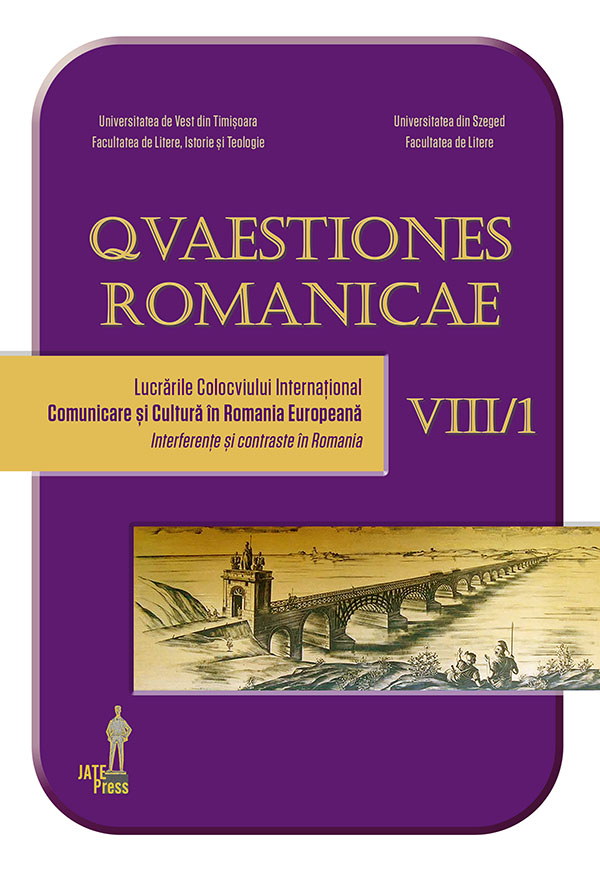Vârstele Letiției Branea. O radiografie a romanelor Gabrielei Adameșteanu
Abstract: (The Ages of Letitia Branea. A Radiography of Gabriela Adamesteanu’s Novels) The paper traces the evolution of a character in three of Gabriela Adamesteanu’s communist/post-communist transition novels. This ambitious narrative project began with Every Day’s Identical Journey (1975), continued with Provisionality (2010) and ended in 2018 with Fontana di Trevi (2018), forming, in the critics’ view, “the Letiţia Branea trilogy”. Our analysis focuses on the relation between personal and recent official history, marked by the politization of intimacy, especially in the representations of feminine bodies (puberty, erotics, pregnancy, abortion, ageing). These are central aspects of Gabriela Adamesteanu’s fiction, relevant for the ethos of the historical moments represented in her novels. The body is at the center of familial, social and economic institutions, being, simultaneously, an instrument and a source of knowledge; a radiograph of the body becomes also a relevant image of the world. This relation explains the frequent photographic or mirror images, representing important mises-en-abyme, marking the difference of perception from the natural to a politicized body. The relations between characters are mediated by the observation of the other’s body (the mother’s, the room-mates’, the lover’s, the husband’s body); the mainly negative bodily self-representations create an intricate game of closure-disclosure, marking the relation with one’s self as well as the heroine’s intimacy. Through this reading, the novels discussed become a testimony about the way in wich both major historical events and the grey of everyday life affect the body representations in Gabriela Adamesteanu’s novels; thus, an analysis of these images is a way of grasping a meaning of particular historical ages.
Keywords: body, feminine erotics, communism, post-communism, transition.
Rezumat: Lucrarea urmăreşte devenirea unui personaj în trei dintre romanele Gabrielei Adameșteanu despre comunism și tranziția postcomunistă. Acest ambițios proiect narativ a început cu Drumul egal al fiecărei zile (1975), a continuat cu Provizorat (2010) şi s-a încheiat în 2018 cu Fontana di Trevi, alcătuind, în opinia criticii, o veritabilă trilogie a Letiției Branea. Analiza pe care o propunem vizează relaţia dintre istoria personală şi istoria oficială recentă, prin politizarea intimităţii, cu referire mai ales la reprezentările corporale feminine (pubertatea, cunoașterea erotică, sarcina, avortul, îmbătrânirea), aspecte prin care aceste proze devin relevante pentru ethosul epocilor pe care le ficţionalizează. Corpul este, la Gabriela Adameșteanu, în centrul instituțiilor familiale, sociale și economice, simultan instrument și sursă de cunoaștere; o „radiografiere” a corpurilor devine și o imagine a lumii comuniste și a societății de tranziție, ceea ce explică frecvența imaginilor fotografice sau speculare în aceste romane, proiecții ce reprezintă veritabile puneri în abis, marcând diferența de percepție de la „corpul natural” la corpul politizat. Relațiile dintre personaje sunt mediate de privirea asupra corpului celuilalt (mama, colegele, iubitul, soțul), iar autoreprezentările corporale, predominant negative, constituind un joc complex de dezvăluire-ascundere, sunt cele care marchează relația cu sine și intimitatea eroinei. În această lectură, romanele discutate devin o mărturie despre felul în care atât evenimentele istorice majore, cât și cenușiul cotidianului afectează reprezentările corporale din romanele Gabrielei Adameșteanu, o analiză asupra acestora fiind și o cale spre cunoașterea unor vârste istorice.
Cuvinte-cheie: corp, erotică feminină, comunism, postcomunism, tranziţie.
